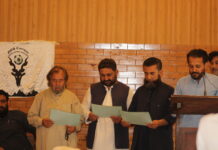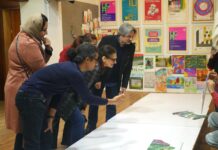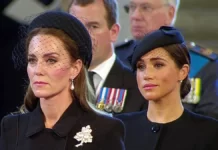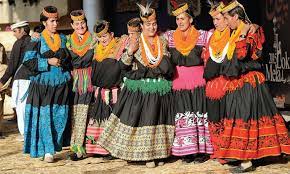ISLAMABAD: Besides several other features for families and children at the on-going ‘Lok Mela’ organized by Lok Virsa, exhibition of artisans-at-work is a major attraction for the visitors.
Over five hundred craftspeople are seen actively demonstrating their works in artistically designed cultural pavilions, putting their creativity in arts, crafts and innovation. They are mesmerizing the visitors with their unique artisanship.
The crafts on display are embroidery including Multani, Bahawalpuri, Hazara, Swati, Balochi and Sindhi embroidery) block printing, lacquer work, Khussa making, pottery, tie and dye, doll making, khaddar weaving, truck art, wood carving, wood work, papier mache, namda and gabba, metal work, shawl weaving, zari work, motikari, traditional carpets, blue pottery, Ajrak, wax printing, stone work, wooden spoon making, pattu weaving and many others.
Being a prime institution dealing with Pakistani folk culture, Lok Virsa is cognizant of the need for gender equality which is seen in each event that it holds from time to time, because in this way both male and female practitioners afford equal opportunity of showcasing their talent and getting due recognition thereof.
In the present event too, one can see a number of female artisans demonstrating their skills. The most prominent among them is Kaneez Fatima and Shakar Bibi from Balochistan. They practice Balochi embroidery and have carried on this centuries old tradition from their mothers and devoted 30 to 35 years of their life to this profession. They stand out not only for their excellence but also in their tireless propagation of this art by imparting it to the future generations.
Another craftswoman Pari Bibi hailing from Badin, Sindh weaves “Farasi” (traditional rug). She is a 70-years old artisan having expertise in the art of weaving since her childhood.
Male artisans are also equally good in showing their artwork. Muhammad Waseem, lacquer work from Khyber Pakhtunkhwa is showcasing excellent display. His father was also an accomplished master craftsman of lacquer art who received pride of performance award in recognition of his talent.
Ameer Bukhsh is an expert in natural dyes from Kahror Pucca. The ancient art of wooden block making has its centres in the lower Indus valley encompassing southern Punjab and all of Sindh. He has not only trained his family members but also imparted training to many artisans in other crafts of textile.
Hajira Bibi from Bahawalpur is an accomplished artisan in basketry. She makes colourful baskets Changair, decorate items from fibroins plant. Pakistan with its rich and varied heritage has a craft tradition of more than 9,000 years dating back to the Mehergarh civilization in Balochistan, when reveals the earliest evidence for pottery production.
The Indus Valley civilization of Mohenjo-Daro in Sindh and Harappa civilization in Punjab (5,000 B.C) indicates impressions of woven cloth production from cotton and wool. The dominant historical influence still to be seen in the form, design and colour of Pakistani handicrafts is essentially. Islamic, a fusion of Turkish, Arab, Persian and the indigenous
Mughal traditions.
The crafts represent a valuable material heritage, which forms a tangible part of our historical and contemporary culture. Unlike the west, most traditional crafts in Pakistan is neither a profession nor a hobby, but an essential component of the diverse cultural patterns-a product of the ethnic and communal attitudes and practices.






















